Saturday, December 06, 2003
Silvered Æ antoninianus, Antioch, Gallienus, Göbl MIR 36, 1622c
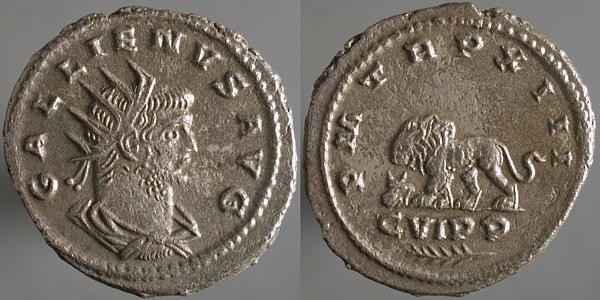
GALLIENVS AVG, Radiate draped cuirassed bust right / PM TR P XIII, Lion walking left toward bucranium. C VI PP over branch in exergue.
C VI P P proclaims Gallienus Consul for the 6th time (combined here with TR P XIII, this dates the coin to between September 265 and one year later) and Pater Patriae. The lion and bull's skull may have some astrological significance.
Friday, December 05, 2003
Æ27, Serdica in Thrace, Gallienus, Moushmov 4953
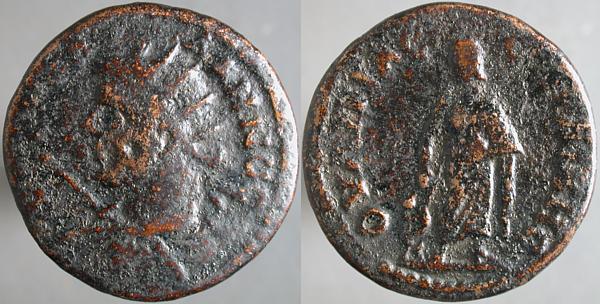
[...]Λ_ΛΠΗΝΟC, Radiate cuirassed bust, with spear and shield, left / ΟVΛΠΙΑC CΕΡΔΕΚΕC, Asclepius standing facing, head left, right hand holding staff with snake.
Another medically-themed coin from Serdica.
A translation of Moushmov is online at Wildwinds, here.
Thursday, December 04, 2003
Billon antoninianus, Antioch, Valerian II, Göbl MIR 36, 1596d
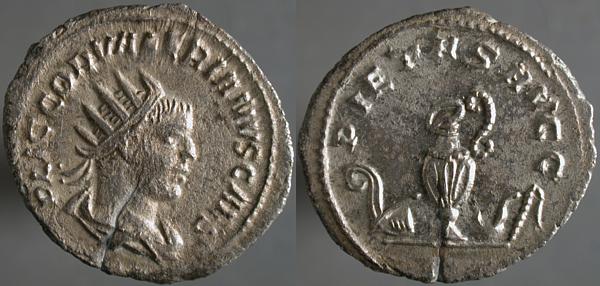
P LIC COR VALERIANVS CAES, Radiate draped bust right / PIETAS AVGG, Sacrificial implements.
Both sons of Gallienus has these PIETAS coins, showing various arrangements of the implements used in the animal sacrifices of the Roman state religion. Similar reverses go back prior to this denarius issued by Sulla to pay his troops in the civil war of 84-83 BCE.
Wednesday, December 03, 2003
AR drachm, Macedon - Philip III Arrhidaeus, 323-317 BCE, Sear Greek 6750var
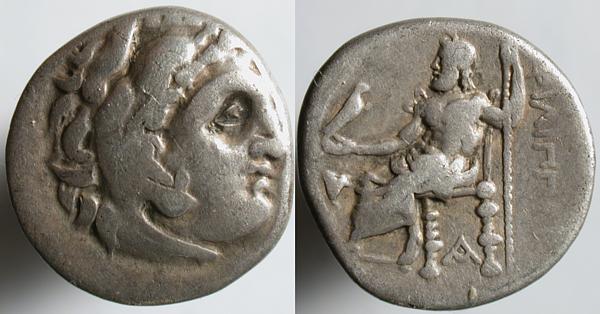
Head of Herakles right, wearing skin of Nemean lion / ΦΙΛΙΠΠ[ΟΥ], Zeus seated left, holding scepter right and eagle left. Ivy leaf in left field, ΛM monogram beneath throne.
The first ancient coin I bought. While reading the third volume of a six-volume edition of Gibbon, it occurred to me that I could buy an ancient coin, something physical that'd been used in antiquity. I knew I couldn't afford gold, and didn't want bronze, so a small silver coin was what I looked for. And found.
Tuesday, December 02, 2003
Not ancient, but interesting
Via Cronaca, the Museum in Docklands, part of the Museum of London to display 17th Century Javanese coins found earlier this year in the Thames.
Æ25, Serdica in Thrace, Gallienus, ?
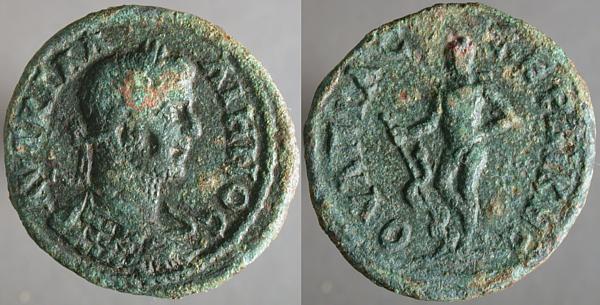
Serdica in Thrace
ΑVΤ Κ ΓΑΛΛΙΗΝΟC, Laureate cuirassed bust right, seen from slightly behind / ΟVΛΠΙΑC CΕΡΔΙΚΗC, Apollo Paeon, nude, standing left, left hand on hip, right hand holding staff with snake.
Not listed in any catalog I own, which may indicate nothing but my lack of good documentation for Serdica provincials. The snake-wrapped staff, frequently an attribute of Apollo's son Asclepius, is here held by Apollo as Paeon, an earlier god of healing. Serdica seems to have issued healing/medicine reverses disproportionately at this time, perhaps not surprising in an era when the Empire was repeatedly swept by plagues.
Monday, December 01, 2003
Silvered Æ antoninianus, Cyzikus, Gallienus, Göbl MIR 36, 1554Ac
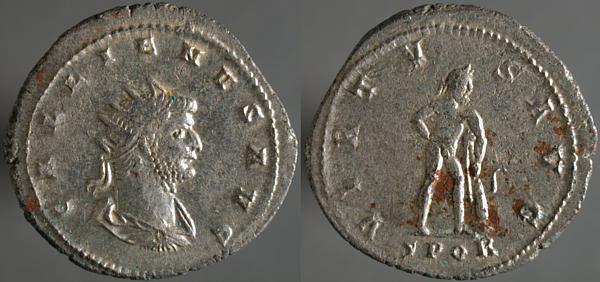
Göbl MIR 36, 1554Ac
GALLIENVS AVG, Radiate draped cuirassed bust right, no pellets beneath / VIRTVS AVG, Hercules standing facing, head right, leaning on club draped in lionskin right. SPQR in exergue.
There remains some controversy about mint assignments for the coins of Gallienus. Per Göbl, Cyzikus is the source of all the coins with SPQR in the exergue and of no other imperial coins.
Cyzikus also minted provincial bronze during this period. The imperial issues presumably occur in 267-268, as Antioch comes under control of Zenobia and her son Vabalathus, technically still Roman allies, but increasingly ambitious. One dealer has told me that he believes all Gallienus's Cyzikus imperial coins were issued in the weeks after he was assassinated. I understood this to mean during the time between his death and the news reaching the mint.
The busts on Cyzikus coins closely resemble those of late-issue Antioch, but are in even lower relief. The officinae are distinguished by pellets beneath the bust (this coin has none, other officinae marked with one or two,) a system no other imperial mint used at this time, but which had recently been used on tetradrachms of Roman Syria. The same pellets and exergue markings appear on the first Cyzikus issues of Claudius Gothicus, successor to Gallienus.
Sunday, November 30, 2003
Æ25, Serdica in Thrace, Gallienus, L. Ruzicka, Die Muenzen von Serdica, Num. Zeitschrift 1914, p. 76 no. 490
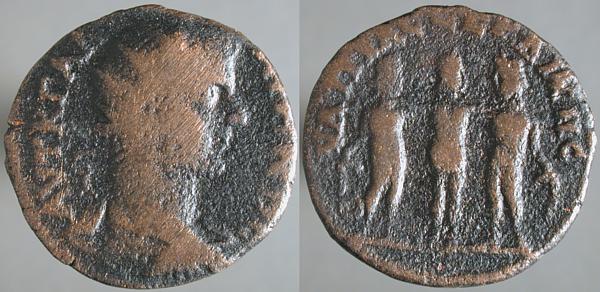
Serdica in Thrace, L. Ruzicka, Die Muenzen von Serdica, Num. Zeitschrift 1914, p. 76 no. 490
ΑVΤ Κ ΓΑΛΛΙΗΝΟC, Radiate cuirassed bust right, seen from slightly behind / ΟVΛΠΙΑC CΕΡΔΙΚΗC, Three graces.
Quite worn, harshly cleaned, perhaps electrolytically. Not likely to see another, though, so that makes it alright.
Sometimes the graces are the daughters of Asclepius, god of Healing and Medicine.

